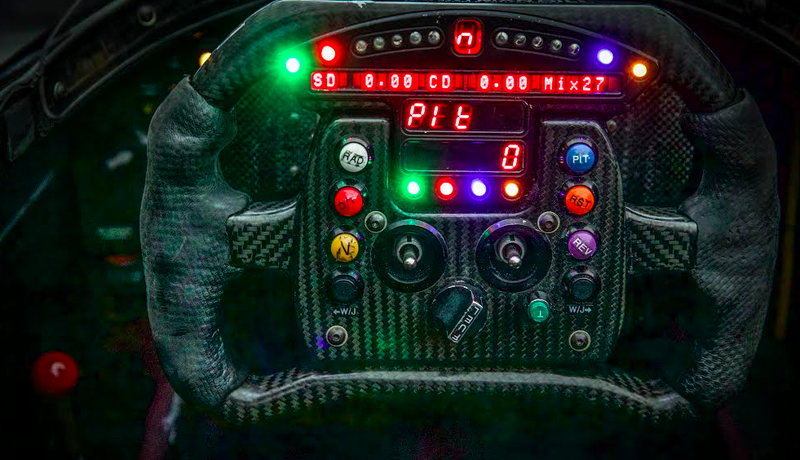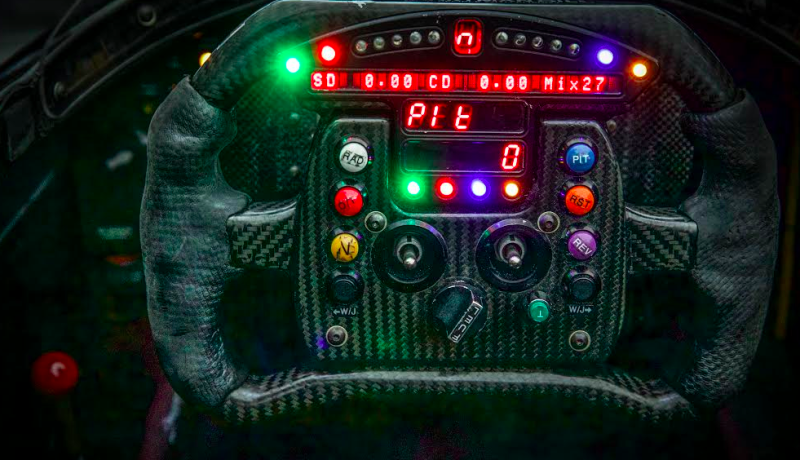
We already know how complicated Formula One steering wheels can be, but are the reins of an IndyCar any simpler? What do all of those buttons do? Here’s a breakdown.
Yesterday, during our live tour of the Dale Coyne IndyCar garage, we learned a lot about how IndyCars work, and we even got a quick explainer on what some of the buttons on the extremely pricey (we’ve heard costs ranging from $25,000 to $40,000) steering wheel do.
But what about the rest of the switches? What are their jobs?
Advertisement
A typical IndyCar steering wheel has 13 main features: a dashboard, RPM shift lights, pit-lane speed limiter, push-to-talk radio switch, fuel-level reset button, fuel-map switch, dash scroll, weight jacker, drink switch, neutral button, reverse, push-to-pass and clutch paddles. Here’s what they all do, as explained by IndyCar:
Dashboard
Sponsored
First there’s the dashboard, which feeds the driver race telemetry and vehicle diagnostic information. IndyCar describes the dashboard, saying:
[The dashboard] displays warning lights and information the driver needs during the race. That information includes lap times, oil, water and gearbox temperatures and fuel mileage.
RPM Shift Lights
If you’re the kind of person who shifts by “feel,” and makes fun of people who watch their revs and shift lights, consider this: IndyCar drivers use shift lights to decide when to switch gears, too. IndyCar says:
LED lights [on the steering wheel]…go from green to red and indicate engine RPM. When the red lights are on the driver shifts gears.
Pit Lane Speed Limiter
Advertisement
To avoid being penalized, teams limit the car’s speed in the pit lane by using a pit lane speed limiter. IndyCar says drivers use the button “to activate the engine control program limiting the car’s speed to the pit lane speed limit, which is usually 60 miles per hour.”
Push-To-Talk Radio Button
To communicate with their teams, drivers press a button just like the one you find on the side of a walkie talkie.
Fuel Reset Button
Drivers have to zero their fuel reading every time they refuel.
Fuel Map Switch
IndyCar describes the fuel map switch, saying:
[The fuel map switch] allows the driver to adjust the fuel mapping of the engine to increase fuel mileage or to increase power. There are a number of settings available including full rich, where the engine produces maximum power but uses more fuel.
There is also a lean setting which uses less fuel but produces less power. During caution periods the drivers will switch to the leanest mixture to increase fuel economy, different pages available on the dash board, including the race page, qualifying page and practice page.
Dash Scroll Buttons or Toggles
The dash scroll buttons or toggle switch let the driver flip through five screens of information on the dashboard to monitor lap times and vehicle diagnostic info.
Weight Jacker Buttons
The weight jacker, a hydraulic cylinder on the springs that adjusts spring rates, can manipulate vehicle weight distribution and thus affect handling. IndyCar describes it, saying:
[A weight jacker] adjusts the cross weight on the car from left to right, or right to left, depending on button pushed. The weight jacker allows the driver to make fine-tuning adjustments as the car begins to handle differently during the race.
Neutral Button
The neutral button is exactly what you think it is: it just puts the transmission in neutral. It’s the button drivers click when they make a pit stop.
Reverse Gear Button
IndyCar actually requires a reverse gear, though you hardly ever see it in use.
Push-To-Pass Button
Then there’s the “Push-To-Pass,” or “Overtake” button, which gives the little 2.2-liter twin-turbo V6 a little more boost.
The push-to-pass, or overtake assist, button is an INDYCAR-regulated mechanism which provides a driver the ability to increase the car’s horsepower for a short period of time.
Hand Clutch Levers
There’s no foot-activated clutch on IndyCars; instead, the clutch is activated with the driver’s hands. There are two clutch pedals on the left and right side of the wheel, and the driver has the choice of which lever to pull to disengage the clutch.
The cool thing is that IndyCars have an anti-stall feature, which makes sure the driver doesn’t screw up and cut the engine out by lifting off the clutch too quickly or not applying enough pedal.
Drink Button
So they don’t lose their concentration, drivers can get a drink by simply pushing a button to activate a water pump. That pump takes water from a bottle installed in the side pod, and pumps it through a tube connected to the driver’s helmet.
Anti-Roll Bar Adjuster Levers
Anti-Roll Bar Adjuster levers aren’t technically on the steering wheel, but they’re still an interesting way the driver can alter the car’s handling from right there in the cabin. Basically, the levers change the car’s roll stiffness in the front and rear, as IndyCar explains:
Allows driver to fine-tune the handling of the car by engaging mechanical linkages connected to the front or rear suspension.
Sure, there are road cars with more buttons on their steering wheels, but can you imagine adjusting your fuel map, sway bars and suspension stiffness while screaming down a racetrack at 240 mph?
Yeah, me neither.













